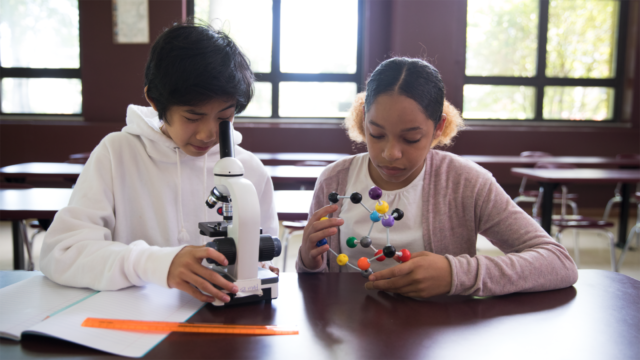
Teaching high school students about nutrition is more than just discussing the benefits of fruits and vegetables, it's about empowering them to make informed choices for a healthy future. National Nutrition Month in March is a great time to consider how food choices impact our health and start developing good eating habits.
“There’s no universal way to eat healthy,” Su-Nui Escobar told Shaped. She’s a dietitian and spokesperson for the Academy of Nutrition and Dietetics, which started National Nutrition Month. "'Personalize Your Plate' is about respecting who we are and where we come from. Start with the way you like to eat, and then figure out how to make it healthy."
The trick is to add nutrition without removing the joy our favorite foods give us. "Young people should be encouraged to play with their food," Escobar says. "Keep it fun. Eating nutritiously doesn't have to feel like a diet." The ideas for nutrition lesson plans and activities for high school that follow will help students accomplish this goal.
Fresh and fun nutrition lesson plans for high school
Kick-start a commitment to healthy eating this National Nutrition Month with these nutrition lesson plan and activity ideas for high school students.
1. Meal makeover
Dietitian Su-Nui Escobar told Shaped that she often turns traditional Mexican favorites into plant-based recipes for her family. She prepares tacos al pastor, which are traditionally made with pork, using jackfruit (a relative of figs), pineapple, and spices. To give pizza a healthy twist, teens might try topping it with plenty of veggies or simply pair it with a side salad jazzed up with roasted vegetables. To satisfy a sweet tooth, cut-up fruit with a drizzle of honey can do the trick. If potato chips and other salty snacks are their go-to, they can swap in air-popped popcorn or kale chips.
You can have students try their hand at transforming a not-so-healthy meal into a more wholesome option. They might choose a traditional family meal or a favorite breakfast, lunch, or snack item and come up with ideas for making it meatless, vegan, higher in fiber, or lower in fat or salt. They should present the revamped recipe along with a paragraph describing the change in ingredients and nutrients.
2. A look at labels
Tell students that reading a nutrition label can help them make informed choices and establish healthy eating habits for a lifetime. You can have students explore the label independently using this interactive from the FDA. Or, you can share the image below to review the label changes with the entire class. Consider these discussion questions: Why do you think "calories" are in large, bold font? Why is it important to take note of the "serving size?" Do you think "added sugars" is a needed addition to the label? Why or why not?
Have students bring in nutrition labels from their favorite foods and drinks to analyze. Give them these tips for evaluating how healthy the foods are:
- 100 calories per serving is considered moderate, while 400 or more calories per serving is considered high in calories.
- 5% Daily Value or less per serving of a nutrient is low; while 20% DV or more per serving of a nutrient is high.
- Nutrients to get more of (strive for 100% DV every day): dietary fiber, vitamin D, calcium, iron, potassium.
- Nutrients to limit: saturated fat, sodium, added sugars, trans fat.

3. Mindful eating
You can tell students that mindful eating means paying attention to the food we buy, prepare, and eat. Savoring each bite we take can put an end to mindless bingeing and lead to better health. Challenge students to give mindful eating a try using a small piece of chocolate, fruit, or vegetable. Have them follow these steps:
- Hold the chocolate in your hand. What does it feel like?
- Study the chocolate. How would you describe it?
- Smell the chocolate. What comes to mind?
- Let the chocolate sit on your tongue. What textures and flavors do you note?
Afterwards, you can discuss the exercise with your students. Ask: Was the experience enjoyable? Why or why not? What did you discover about your eating habits? What do you think is the purpose behind eating mindfully? Will you continue to eat mindfully? Explain.
4. Got fruits and veggies?
Challenge students to design an ad for a vegetable or fruit of their choice. Tell them their goal is to convince teens to eat the avocado, arugula, asparagus, papaya, mango, pear, or other produce that they are promoting. The campaign should convey:
- Benefits of eating the vegetable or fruit.
- Excitement for the product using a catchy tagline Example: Got Milk? (California Milk Processor Board), I’m Lovin' It (McDonald’s).
Tell students the trick is to create a campaign that appeals to teens and their values. They should also consider the best medium to reach their audience—maybe it’s a social media platform, or maybe it’s a billboard, print magazine, or TV ad. You should allow time for students to present their campaigns to the class and get feedback.

5. Ready, set, cook!
Invite a local chef to do a super-simple healthy cooking demo over Zoom or another platform for your students. Give the guest some guidelines. The recipe should
- Use inexpensive and easy-to-find ingredients.
- Require only common kitchen tools.
- Include tips for making the recipe vegetarian, vegan, or gluten-free.
- Be made available to students before the demo.
If you can’t book a local chef, you can show students how to make a healthy snack yourself or invite a student to take on the demo. You might give students the option of recording themselves making the snack and sharing the video with the class instead of doing a live demo.
Yet another option is to simply share one of the many cooking videos on the Academy of Nutrition and Dietetics website. You'll find video how-to's for making no-bake chocolate cherry oat bars, pizza hummus, or healthy Alfredo bagel bites. Encourage students to make one of the recipes and write a review of the food that includes a photo of the final product.
6. The dietitian is in
Invite a local dietitian to answer students’ questions about nutrition. You can have students read up on the dietitian’s background and expertise beforehand. You may want to brainstorm a list of questions that students would like to ask, keeping in mind the dietitian’s expertise. Encourage students to ask follow-up questions during the talk. For homework, have students write a paragraph explaining how they will incorporate one piece of nutrition advice that the dietitian shared into their daily routine.
7. Nutrition know-how
Test students’ knowledge of nutrition with this quiz from the Academy of Nutrition and Dietetics. Read each statement aloud and have students determine if it’s “fact” or “fiction,” using an online polling tool like Kahoot.
Did students have trouble telling fact from fiction? Have them choose one statement they identified incorrectly. Then have them do research to determine why the statement is true or false. For an added challenge, have students choose a health trend they’re interested in, such as plant-based or low-carb diets, mindful eating, environmentally-friendly nutrition, the brain-gut connection, probiotics, organic foods, and the like. Then have them write a quiz (they can make it interactive using Kahoot or another online tool) using facts they find in their research. Remind them to include an answer key that explains why each statement is true or false.
More nutrition lesson plans for high school classrooms
There are many more nutrition resources for high school available on the Academy of Nutrition and Dietetics website to help you start your discussion about nutrition. When students understand the value of nutrition they are more likely to make informed decisions and develop healthy eating habits.
Have more nutrition lesson plan and activity ideas for high school students? Share your ideas with us on Facebook, Instagram, or via email at shaped@hmhco.com.
***
Learn more about HMH Science Dimensions, enabling teachers to guide K–12 students in learning through exploration, analysis, application, and explanation.
This blog, originally published in 2021, has been updated for 2025.
Download our FREE calendar of activities.














